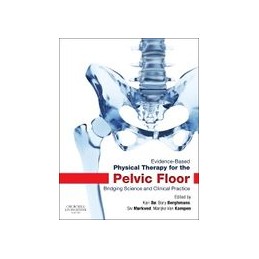- Reduced price

Order to parcel locker

easy pay


 Delivery policy
Delivery policy
Choose Paczkomat Inpost, Orlen Paczka, DHL, DPD or Poczta Polska. Click for more details
 Security policy
Security policy
Pay with a quick bank transfer, payment card or cash on delivery. Click for more details
 Return policy
Return policy
If you are a consumer, you can return the goods within 14 days. Click for more details
Bridging the gap between evidence-based research and clinical practice, Physical Therapy for the Pelvic Floor has become an invaluable resource to practitioners treating patients with disorders of the pelvic floor. The second edition is now presented in a full colour, hardback format, encompassing the wealth of new research in this area which has emerged in recent years.
Kari Bř and her team focus on the evidence, from basic studies (theories or rationales for treatment) and RCTs (appraisal of effectiveness) to the implications of these for clinical practice, while also covering pelvic floor dysfunction in specific groups, including men, children, elite athletes, the elderly, pregnant women and those with neurological diseases. Crucially, recommendations on how to start, continue and progress treatment are also given with detailed treatment strategies around pelvic floor muscle training, biofeedback and electrical stimulation.
..a comprehensive review of every aspect of this area including female, male and childhood issues, incontinence, prolapse, pain and sexual dysfunction. Reviewed by Beatrice McGinley on behalf of Physiotherapy Practice and Research, October 2015
Data sheet
1. OVERVIEW OF PHYSICAL THERAPY FOR PELVIC FLOOR DYSFUNCTION Kari Bř
2. CRITICAL APPRAISAL OF RANDOMIZED TRIALS AND SYSTEMATIC REVIEWS OF THE EFFECTS OF PHYSICAL THERAPY INTERVENTIONS FOR THE PELVIC FLOOR Rob Herbert
3. FUNCTIONAL ANATOMY OF THE FEMALE PELVIC FLOOR James A Ashton-Miller, John OL DeLancey
4. NEUROANATOMY AND NEUROPHYSIOLOGY OF PELVIC FLOOR MUSCLES David B Vodusek
5. MEASUREMENT OF PELVIC FLOOR MUSCLE FUNCTION AND STRENGTH, AND PELVIC ORGAN PROLAPSE
5.1 Introduction Kari Bř
5.2 Visual observation and palpation Kari Bř
5.3 Electromyography David B Vodusek
5.4 Vaginal squeeze pressure measurement Kari Bř
5.5 Pelvic floor dynamometry Chantale Dumoulin, Mélanie Morin
5.6 Urethral pressure measurements Mohammed Belal, Paul Abrams
5.7 Ultrasound in the assessment of PFM and pelvic organ descent Hans Peter Dietz
5.8 MRI of intact and injured female pelvic floor muscles John OL DeLancey, James A Ashton-Miller
6. PELVIC FLOOR AND EXERCISE SCIENCE
6.1 Motor learning Kari Bř, Siv Mřrkved
6.2 Strength training Kari Bř, Arve Aschehoug
7. FEMALE PELVIC FLOOR DYSFUNCTIONS AND EVIDENCE-BASED PHYSICAL THERAPY
7.1 Female stress urinary incontinence Prevalence, causes and pathophysiology Jacques Corcos Lifestyle interventions Pauline Chiarelli Bladder training Jean F Wyman Pelvic floor muscle training for SUI Kari Bř Electrical stimulation for SUI Bary Berghmans
7.2 Female overactive bladder Pelvic floor muscle training for overactive bladder Kari Bř Electrical stimulation for overactive bladder Bary Berghmans
7.3 Urinary incontinence related to the peripartum period Siv Mřrkved, Kari Bř
7.4 Pelvic organ prolapse Clinical assessment of pelvic organ prolapse Matthew D Barber Use of pessaries to prevent and treat pelvic organ prolapse Patricia Neumann Pelvic floor muscle training in prevention and treatment of pelvic organ prolapse Kari Bř, Helena Frawley
7.5 Female sexual dysfunction Assessment Alessandra Graziottin Treatment Alessandra Graziottin, Dania Gambini
8. MALE PELVIC FLOOR DYSFUNCTIONS AND EVIDENCE-BASED PHYSICAL THERAPY
8.1 Urinary incontinence and other lower urinary tract symptoms Marijke Van Kampen, Inge Geraerts
8.2 Male sexual dysfunction Grace Dorey
9. EVIDENCE-BASED PHYSICAL THERAPY FOR PELVIC FLOOR DYSFUNCTIONS AFFECTING BOTH WOMEN AND MEN
9.1 Anal incontinence Epidemiology, anatomy and pathophysiology, and risk factors Bary Berghmans, Esther Bols, Ylva Sahlin, Espen Berner Assessment of the nature and severity of AI Bary Berghmans, Esther Bols Conservative interventions for treatment of AI Bary Berghmans, Esther Bols
9.2 Pelvic floor pain and the overactive pelvic floor Helena Frawley
10. EVIDENCE FOR PELVIC FLOOR PHYSICAL THERAPY IN CHILDREN Wendy F Bower
11. PELVIC FLOOR PHYSICAL THERAPY IN THE ELDERLY: WHERES THE EVIDENCE? Adrian Wagg
12. EVIDENCE FOR PELVIC FLOOR PHYSICAL THERAPY FOR NEUROLOGICAL DISEASE Marijke Van Kampen, Inge Geraerts
13. PELVIC FLOOR DYSFUNCTION, PREVENTION AND TREATMENT IN ELITE ATHLETES Kari Bř
14. THE DEVELOPMENT OF CLINICAL PRACTICE GUIDELINES Bary Berghmans, Erik Hendricks, Nol Bernards, Rob de Bie
Reference: 42325
Author: James K. Stoller
Reference: 15628
Author: Romuald Dębski
Seria "W gabinecie lekarza specjalisty. Ginekologia i położnictwo"
Reference: 16999
Author: red. wyd. pol. Marcin Szkolnicki
Metody stymulujące gojenie się ran i usprawniające funkcjonowanie układu powięziowego
Reference: 17079
Author: red. wyd. pol. Edward Saulicz
